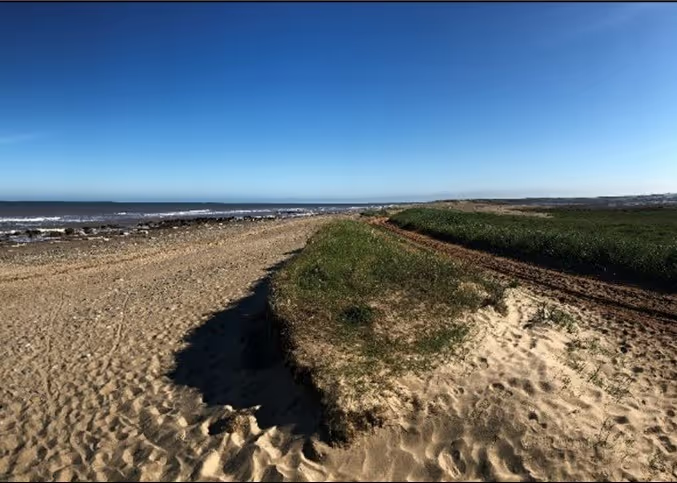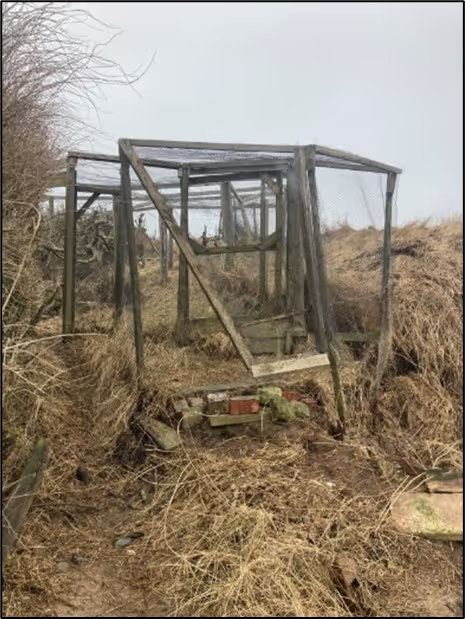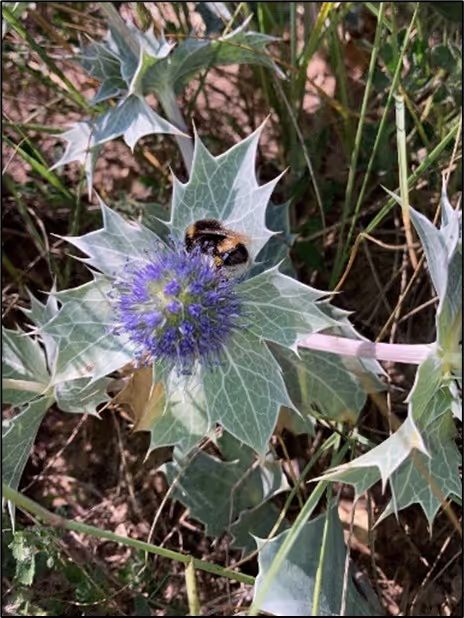
Prologue: Here
It’s October 1961. Philip Larkin has just written Here, the opener of The Whitsun Weddings. It tells of Hull, ‘the surprise of a large town’, and the surrounding area, which the poet has been exploring by bike. On the other side of the Pennines, my parents have no notion of moving to the East Riding of Yorkshire. By the time I arrive on the scene, nine months later, my dad will have decided to leave hospital work in Kendal and become a GP. He and my mum will reject urban Wolverhampton, preferring the flat farmland to the east of Hull.
‘Beyond its mortgaged half-built edges’
I’m glad my parents chose to head to Larkin’s ‘isolate villages’. If I’d grown up in the Black Country, I wouldn’t be lying here on this warm May morning. I’m in a dip in the dunes of Spurn’s weird landscape. It’s a great spot for a rest after the three-mile walk down the peninsula. I can just about hear the gentle plash of slack-tide waves collapsing apologetically onto the nearby beach. A punk fringe of spiky marram hems me in. From this hollow, I can barely feel the gently shifting breeze. The only evidence of humanity is the top half of a black-and-white hooped lighthouse. The warm sand cradles me snugly. I don’t want to move.

My sixtieth birthday is coming soon. I’ve come here to honour a place which, uniquely, I’ve visited at least once in each year of my life. This longshore drift accumulation of impermanence has become a permanent thread in my life. It’s always worth getting past traffic-clogged Hull, then through the neutral flatlands, to reach this low-lying barrier. With its luminous liquidity, it has a washing and rinsing quality. Others have recognised this. Ecologists, geographers, historians and, in Hullspeak, ‘lercals’ will tell you in prose about its strange past and shifting present, but for me this is a poetic place of calm. I find contentment here. Verse comes out easily.
‘Swerving east’
My parents watched me take some of my first steps on Spurn’s beach. In these dunes I schooled my children in the frantic liberty of repeatedly hurling oneself off a narrow shelf and tumbling down a soft-landing ramp. These days, I bring my mum here, for what both of us know, but don’t say out loud, will be some of her last nature walks.
Does all of that suggest this is where I’m rooted? In some ways. But it’s not that simple. I was born on the other side of the country. I lived fifteen miles from Spurn for the first eighteen years of my life, but I left easily after my schooling. I played football and cricket for local villages, but never felt a part of the tight Holderness community. I resist saying that I’m from here. It’s a struggle to think of the East Riding as ‘home’, however strongly I’m attached to this thin peninsula, this quirk on the map.

My swerving east was an accident. I love the wild west coast, battered as it is by oceanic waves, shaped by Celtic and Viking history, but I’ve grown to love this east-facing coast too. It presents itself more subtly, the tale of invisible Doggerland told only by archaeologists. There’s no drop from the Continental Shelf, which is why on today’s horizon phalanxes of wind turbines stand in rows, their gull white blades catching the sun. The container ships I’ll watch later in the day departing on the tide will head out over what was once tundra. One day, very soon in the geological scheme of things, these flat acres at the Humber’s mouth will go the same way as Doggerland: Sunk Island will be sunk again. The estuary-side Greedy Gut will live up to its name and swallow what I’ve walked over as land. It’s just a question of when. Spurn already becomes an island at the highest tides. Successive winter storms, when the tide rises high, widen the breach between the mainland and the tadpole-shaped tract that points out to the Bull Light Float and Lincolnshire beyond.

Each trip from Oxfordshire takes me through familiar villages, where dad’s patients lived. In spring especially, heading down the narrow road to Kilnsea and Spurn, anticipation rises. I ready myself to spot the latest storm damage, the fresh evidence of disappearance. On my swerve east earlier this year, I was taken aback by the sight of low clay cliffs eroded in one winter by half a cricket pitch’s length. I winced at the sight of the mangled bird-ringing trap, left dangling precariously over the sand.

I sometimes wonder whether I’ve become hooked on the death throes of the place. I note every dent, prang and gouge to the peninsula, the erosion accelerated since the big breach of December 2013. In one night, the biggest tidal surge for six decades undid 150 years of work by coastal defences. I excuse myself on the grounds that I feel these hits personally – a cherished past is assaulted with each loss, each extension of the divide. So I keep swerving east: I need to visit as often as I can a sanctuary which is neither enduring nor surviving. In my lifetime, Spurn is evolving, irreversibly, into a full-time island. I’m going to see it fully moated.
‘Unfenced existence’
Back in the 60s and 70s, I was looking for fun and hiding places, not signs of change. The dunes and relic military buildings rose high. To a child, this was a stable idyll. My birthday parties were always here: camping stove on the beach, mum on a rug in front of the primary-coloured windbreak, the slightly battered Thermos flask, full of coffee. Dogs were banned, but we smuggled ours in sometimes. As a teenager, I found a loose association between the tank traps and the Cold War tension we all felt back then. This was our unfenced existence, among crumbling towers and tunnels; we scampered up, clambered around, and investigated down all manner of half-ruins, hiding-and-seeking in soldiers’ haunts. Eventually, the shells of buildings were demolished, around the time my adolescent freedom collapsed into adulthood. I can’t be sure exactly where these buildings stood. Somewhere between here and the lighthouse. But time, tide and shifting sand have erased so much.
I’m ready to leave my bunker, to wander over the humped and hollowed ground. From the humps I see swallows, hear whitethroats, spot gulls and a pair of oystercatchers on the beach. In the hollows I catch the buzz of a bee, take in the coconut aroma of the abundant gorse, sidestep the sea holly which promises violet delight in high summer. I’m retreating over ground trodden by soldiers, by friends, by me.
I run into a tour guide and his group by the lighthouse, overhearing his confident narrative. It’s one of the ‘Military Safari’ trips down to the end of Spurn. There, they’ll see the massive blocks of gun emplacements, now largely buried, but with enough concrete visible to create a powerful impression.

I wonder if the guide has told them about the bungalow that used to stand by the road, just a couple of hundred metres back? There’s no trace these days of the verandahed construction that once served as the Officers’ Mess. South-facing, it enjoyed the sun in the daytime, and suffered the beam of the lighthouse by night. Sometimes, I stayed overnight in this building, the only one on the peninsula that wasn’t used by lifeboatmen, river pilots or wildlife rangers. I saw it as entirely normal to wake up to a Spurn dawn, though it obviously wasn’t. From here I would wander off to watch waders, or to seek and identify spring migrants. It doesn’t matter whether I enjoyed the freedom or the nature more: the two became the same.

‘Here silence stands’
Between the lighthouse and the point is where people have made their greatest mark. The lifeboat station and Humber pilot service still operate. But it’s eerily quiet today, even among the buildings. There are no families in the lifeboatmen’s cottages. In more populated times, dad’s practice used to extend all the way down here. GP night calls were still a part of his generation’s duty. He’d drive past the fast-shadowed wheat fields to this distant corner of his patch, spotting barn owls in the moonlight along the way.
During the war years, it was lively down here. Spurn’s projection into the estuary meant it met the German bombers first. In the first war, airships; in the second, the drone of Heinkels and Dorniers. Just north of Spurn is a remarkable relic – an east-facing concave bowl of concrete, a sound mirror to detect approaching airships. Every summer, I make a pilgrimage to check on the little tern colony that thrives on the beach nearby, protected by an electric fence. Echoing the anti-aircraft guns of the battery, the adults scream out their warnings at any invaders.
When I finally reach the rounded tip of the peninsula, I see the busy shipping lane that passes between here and Grimsby. The towering container ships are starting to move, now that the tide is working for them. I’m taken back to the blasts of ship horns I heard as a child, and, with less affection, the smell of the fish meal plant upwind from my school. Before I know it, I’m reimagining the sight of trawlers leaving for the perilous Arctic, Lowryesque men visible on deck. From this ‘end-of-the-world’ spot, faraway places were brought near, most dramatically in 1982 when we watched the Norland (in normal times a Hull-Rotterdam ferry) heading out to the Falklands as a troop ship.
Today, a Dutch-flagged yacht passes close to the shore. The skipper and I exchange waves. It’s a surprisingly intimate moment. And then I turn to make the long walk back, along the estuary side, where the tide-scoured sand reveals its fresh and unique barcodes.

‘Out of reach’
It’s time to leave. These days, I don’t find that easy. It’s the prospect of termination of a lifelong relationship that unsettles, no question. Inevitably, I find myself wondering whether Spurn will be completely washed through by the time I’m here again. The sand and shingle stretch is now more than 400 metres. Passing over this seems like a prelude to a greater passing. Masking these thoughts on this blue-sky day, I step to the side of the road as the Yorkshire Wildlife Trust’s ‘Unimog’ ex-military vehicle exits the breach. It’s ferrying another group of smiling visitors to the far end.
At the mid-point of the breach, I pause to imagine what it will be like when the ‘perfect storm’ strikes. The wind will whip in from the Baltic, the tide will be at its highest, and the waves will smash the weakest link. The sight of the concrete roadway blocks poking through the sand – the very ones we drove over even in this century – helps me to picture the next violent chapter.
I’ll get the phone call from my mum or a message from a friend: it will feel like a death in the family. Longshore drift will build sand and shingle into a new shape on the map. But it will be an island, and it will be severed. Those of us who love this causeway stretch and what it leads to, the perfect vantage point for the Humber’s often glorious sunsets, will look across at somewhere out of bounds. I’ll remember the common blues, ringlets and small heaths, and wonder how their successors are faring. I’ll recall the dawn when I heard and saw the grasshopper warbler, so close. I won’t forget the July afternoon on the seaward side, when I chanced to see the hepatic cuckoo battling to make migration headway. But the price of such joyous memories will be grief – grief for the loss of a special place. As if in fulfilment of the closing words of Larkin’s 60-year-old poem, Spurn will have become ‘out of reach’. Until that day comes, I still have it.
'Ends The Land Suddenly' was first published by Little Toller Books of Beaminster, Dorset and we are indebted to them and Paul for sharing this wonderful essay with Mag North.
Paul Gamble lives close to Oxford, but maintains strong links with the East Riding, where he spent his childhood and school days. After a career teaching Classics, he now writes about the nature and landscape of coasts and hills. He is currently studying for an MA in Travel and Nature Writing. More of his writing can be seen at www.aleatorscribit.org